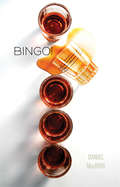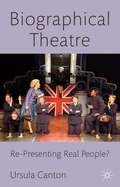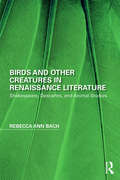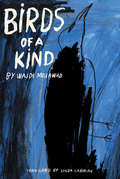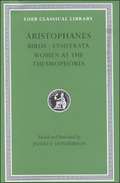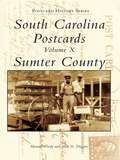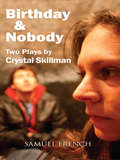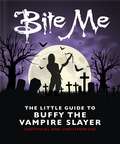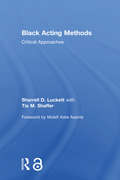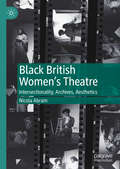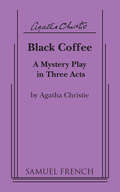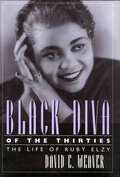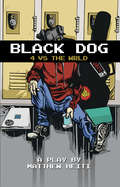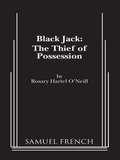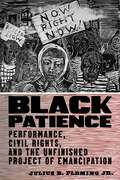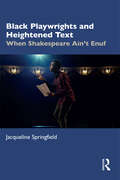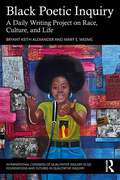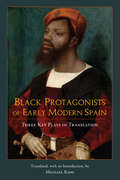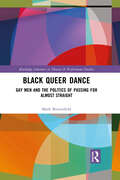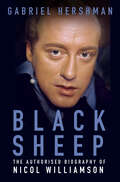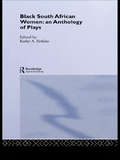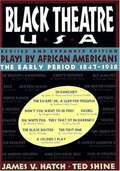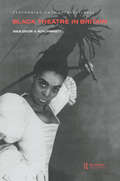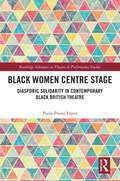- Table View
- List View
Bingo!
by Daniel MacivorFive classmates come together for their thirtieth high-school reunion. Some see it as a welcome trip home, while others see it as an obligation, and a few never even left. But as the night wears on, the one-time classmates start to reconnect and reminisce. And the more alcohol that’s consumed the closer the friends come to confronting their darkest secrets. Once again, Daniel MacIvor proves to us that just because we’re all grown up doesn’t mean we have everything figured out. His characters are sometimes naive, often crass, but always honest. As they try to reclaim their high-school glory days, these five friends charge headfirst into the secrets they all tried to run so far from.
Biographical Theatre
by Ursula CantonMarilyn Monroe, Vincent van Gogh or the victims of rendition flights - the number and variety of historical and contemporary figures represented on British stages is amazing. This book develops a new theoretical framework for the representation of real life figures on stage and examines different ways in which they can be included in performances.
Birds and Other Creatures in Renaissance Literature: Shakespeare, Descartes, and Animal Studies (Perspectives on the Non-Human in Literature and Culture)
by Rebecca Ann BachThis book explores how humans in the Renaissance lived with, attended to, and considered the minds, feelings, and sociality of other creatures. It examines how Renaissance literature and natural history display an unequal creaturely world: all creatures were categorized hierarchically. However, post-Cartesian readings of Shakespeare and other Renaissance literature have misunderstood Renaissance hierarchical creaturely relations, including human relations. Using critical animal studies work and new materialist theory, Bach argues that attending closely to creatures and objects in texts by Shakespeare and other writers exposes this unequal world and the use and abuse of creatures, including people. The book also adds significantly to animal studies by showing how central bird sociality and voices were to Renaissance human culture, with many believing that birds were superior to some humans in song, caregiving, and companionship. Bach shows how Descartes, a central figure in the transition to modern ideas about creatures, lived isolated from humans and other creatures and denied ancient knowledge about other creatures’ minds, especially bird minds. As significantly, Bach shows how and why Descartes’ ideas appealed to human grandiosity. Asking how Renaissance categorizations of creatures differ so much from modern classifications, and why those modern classifications have shaped so much animal studies work, this book offers significant new readings of Shakespeare’s and other Renaissance texts. It will contribute to a range of fields, including Renaissance literature, history, animal studies, new materialism, and the environmental humanities.
Birds of a Kind
by Wajdi MouawadIs it really important to cling to our lost identities? A terrorist attack in Jerusalem puts Eitan, a young Israeli-German genetic researcher, in a coma, while his girlfriend Wahida, a Moroccan graduate student, is left to uncover his family secret that brought them to Israel in the first place. Since Eitan’s parents erupted at a Passover meal when they realized Wahida was not Jewish, he has harboured a suspicion about his heritage that, if true, could change everything. In this sweeping new drama from the prolific Wajdi Mouawad, the Israeli-Palestinian conflict hits close to home as a straitlaced family is forced to confront everything they know about their identities.
Birds, Lysistrata, Women at the Thesmophoria
by Aristophanes Jeffrey HendersonAristophanes (c. 450 c. 386 BCE) has been admired since antiquity for his wit, fantasy, language, and satire. The protagonists of Birds create a utopian counter-Athens. In Lysistrata wives go on conjugal strike until their husbands end war. Women in Women at the Thesmophoria punish Euripides for portraying them as wicked.
Birmingham's Theater and Retail District (Images of America)
by Tim HollisFrom the 1890s to the 1970s, the thriving area of Birmingham between Eighteenth and Twenty-first Streets along First, Second, and Third Avenues was the bustling heart of this quickly growing city. Before the age of the shopping mall, the downtown was the center of retail and entertainment in Birmingham. Along these streets, entrepreneurial immigrants built department stores--including Pizitz and Loveman, Joseph, and Loeb--while the marquees of the Alabama, Ritz, and Lyric theaters, among others, shined over the busy downtown sidewalks.
Birthday And Nobody
by Crystal SkillmanCollection of two plays. In Birthday, an anxious young woman slips away from a unwelcoming birthday party in a bar only to discover a stranger sitting in the other room. Confiding old secrets and past mistakes as the party rages nearby, they find they may have a chance to forgive themselves and each other. In Nobody six people come together, each for their own reasons, at a restaurant on the Lower East Side. Obsessively going over the events of the day, they grasp at trying to come to terms with their disjointed lives and their singular, unsettling dream.
Bite Me: The Little Guide to Buffy the Vampire Slayer
by Orange Hippo!"I'm Buffy, the vampire slayer. And you are?"A prestige show that was ahead of its time, Buffy the Vampire Slayer brought vampires back into the mainstream and made stars of its cast, and its impact has lasted long after the show's end. With its unique blend of high-school drama, witty banter and the supernatural, Buffy the Vampire Slayer became known for ushering in golden age of television. With a devoted cult following and a growing new audience, Buffy remains a cultural icon.Reminisce some of the most iconic quotes you've ever heard in your life (or "unlife") in The Little Guide to Buffy the Vampire Slayer, filled with quips and facts about the adventures of the famous slayer and her friends against the forces of darkness."In every generation, there is a chosen one. She alone shall stand against the vampires, demons and forces of darkness. She is the slayer."Spike's trademark coat cost $2,000 from a top fashion store. It was then run over repeatedly by a truck to give it that distressed look.
Bite Me: The Little Guide to Buffy the Vampire Slayer
by Orange Hippo!"I'm Buffy, the vampire slayer. And you are?"A prestige show that was ahead of its time, Buffy the Vampire Slayer brought vampires back into the mainstream and made stars of its cast, and its impact has lasted long after the show's end. With its unique blend of high-school drama, witty banter and the supernatural, Buffy the Vampire Slayer became known for ushering in golden age of television. With a devoted cult following and a growing new audience, Buffy remains a cultural icon.Reminisce some of the most iconic quotes you've ever heard in your life (or "unlife") in The Little Guide to Buffy the Vampire Slayer, filled with quips and facts about the adventures of the famous slayer and her friends against the forces of darkness."In every generation, there is a chosen one. She alone shall stand against the vampires, demons and forces of darkness. She is the slayer."Spike's trademark coat cost $2,000 from a top fashion store. It was then run over repeatedly by a truck to give it that distressed look.
Black Acting Methods: Critical Approaches
by Sharrell Luckett Tia M. ShafferBlack Acting Methods seeks to offer alternatives to the Euro-American performance styles that many actors find themselves working with. A wealth of contributions from directors, scholars and actor trainers address afrocentric processes and aesthetics, and interviews with key figures in Black American theatre illuminate their methods. This ground-breaking collection is an essential resource for teachers, students, actors and directors seeking to reclaim, reaffirm or even redefine the role and contributions of Black culture in theatre arts.
Black British Women's Theatre: Intersectionality, Archives, Aesthetics
by Nicola AbramThis book marks a significant methodological shift in studies of black British women’s theatre: it looks beyond published plays to the wealth of material held in archives of various kinds, from national repositories and themed collections to individuals’ personal papers. It finds there a cache of unpublished manuscripts and production recordings distinctive for their non-naturalistic aesthetics. Close analysis of selected works identifies this as an intersectional feminist creative practice. Chapters focus on five theatre companies and artists, spanning several decades: Theatre of Black Women (1982-1988), co-founded by Booker Prize-winning writer Bernardine Evaristo; Munirah Theatre Company (1983-1991); Black Mime Theatre Women’s Troop (1990-1992); Zindika; and SuAndi. The book concludes by reflecting on the politics of representation, with reference to popular postmillennial playwright debbie tucker green. Drawing on new interviews with the playwrights/practitioners and their peers, this book assembles a rich, interconnected, and occasionally corrective history of black British women’s creativity. By reproducing 22 facsimile images of flyers, production programmes, photographs and other ephemera, Black British Women’s Theatre: Intersectionality, Archives, Aesthetics not only articulates a hidden history but allows its readers their own encounter with the fragile record of this vibrant past.
Black Coffee
by Agatha ChristieFull Length Play / Dramatic Comedy, Mystery Thriller / 10m, 3f / Interior Set. This little known mystery will surprise and delight Christie fans. The story concerns a physicist named Sir Claude Amory who has come up with a formula for an atom bomb (Black Coffee was written in 1934!). In the first act, Sir Claude is poisoned (in his coffee, naturally) and Hercule Poirot is called in to solve the case. He does so after many wonderful twists and turns in true Christie tradition.
Black Diva of the Thirties: The Life of Ruby Elzy (Willie Morris Books in Memoir and Biography)
by David E. WeaverWhile undergoing routine surgery to remove a benign tumor, Ruby Elzy died. She was only thirty-five. Had she lived, she would have been one of the first Black artists to appear in grand opera. Although now in the shadows, she was a shining star in her day. She entertained Eleanor Roosevelt in the White House. She was Paul Robeson's leading lady in the movie version of The Emperor Jones. She starred in Birth of the Blues opposite Bing Crosby and Mary Martin. She sang at Harlem's Apollo Theater and in the Hollywood Bowl. Her remarkable soprano voice was known to millions over the radio. She was personally chosen by George Gershwin to create one of the leading roles in his masterpiece, that of Serena in the original production of Porgy and Bess. Her signature song was the vocally demanding “My Man's Gone Now.” From obscurity she had risen to great heights. Ruby Pearl Elzy (1908-1943) was born in abject poverty in Pontotoc, Mississippi. Her father abandoned the family when she was five, leaving her mother, a strong, devout woman, to raise four small children. Ruby first sang publicly at the age of four and even in childhood dreamed of a career on the stage. Good fortune struck when a visiting professor, overwhelmed upon hearing her beautiful voice at Rust College in Mississippi, arranged for her to study music at Ohio State University. Later, on a Rosenwald Fellowship, she enrolled at the Juilliard School in New York City. After more than eight hundred performances in Porgy and Bess, she set her sights on a huge goal, to sing in grand opera. She was at the peak of her form. While she was preparing for her debut in the title role of Verdi's Aida, tragedy struck. During her brief career, Ruby Elzy was in the top tier of American sopranos and a precursor who paved a way for Leontyne Price, Jessye Norman, Kathleen Battle, and other black divas of the operatic stage. This biography acknowledges her exceptional talent, recognizes her contribution to American music, and tells her tragic yet inspiring story.
Black Dog: 4 vs the wrld
by Matthew HeitiThe Breakfast Club meets Shirley Jackson in a fusion of live theatre and technology that tells a darkly comic but hopeful story of four teenage outsiders struggling with death, depression and the shadow of a black dog. Two is fraught. While dealing with the impossible expectations of her parents, she is trying to understand why her brother, a bright and talented teenager, has taken his own life. It’s not until a fateful school detention that she meets three other students who all seem as lost as she is. There’s Three, a quiet, misunderstood guy who doesn’t quite know how to care for himself; Four, the fashionable, popular kid and class clown; and Five, a rebel ready to fight against everyone and everything. Despite their differences, they each grapple with depression and anxiety and become an unlikely source of comfort to one another. As the four unite to battle teachers, parents, therapists and their own demons, their promising futures begin to reveal themselves.
Black Jack
by Rosary Hartel O'NeillFull Length, Southern Comedy CharacterS: 2 male, 4 female. Unit Set. Blackjack follows an eccentric Southern family as it is squeezed into the close quarters of a Mississippi cruise ship for the New Year's holiday. Kaitlyn is convinced that she is channeling the poet Baudelaire, and certain that her husband is having an affair with a larger-than-life ship entertainer. Irene, the matriarch of the family, suspects a rift in her daughter's marriage. Her sexy maid sets her sights on the grandson, a successful Southern rock star. Everyone dons costumes for New Year's Eve, casting off their old identities and trying on new loves. . Also available in A Louisiana Gentleman and other New Orleans Comedies
Black Patience: Performance, Civil Rights, and the Unfinished Project of Emancipation (Performance and American Cultures)
by Julius B. Fleming Jr.Honorable Mention, 2024 Callaway Prize for the Best Book on Drama, Theatre, and Performance Studies (New York University)2024 College Language Association Book Award Winner2023 Hooks National Book Award Winner (Benjamin L. Hooks Institute for Social Change)Honorable Mention, Association for the Study of the Arts of the Present 2023 Book PrizeHonorable Mention, 2023 John W. Frick Book Award (American Theatre and Drama Society)Finalist, 2022 George Freedley Memorial Award of the Theatre Library Association.Finalist, Barnard Hewitt Award for Outstanding Research in Theatre History (ASTR)Finalist, ATHE Outstanding Book AwardA bold rethinking of the Civil Rights Movement through the lens of Black theater“Freedom, Now!” This rallying cry became the most iconic phrase of the Civil Rights Movement, challenging the persistent command that Black people wait—in the holds of slave ships and on auction blocks, in segregated bus stops and schoolyards—for their long-deferred liberation. In Black Patience, Julius B. Fleming Jr. argues that, during the Civil Rights Movement, Black artists and activists used theater to energize this radical refusal to wait. Participating in a vibrant culture of embodied political performance that ranged from marches and sit-ins to jail-ins and speeches, these artists turned to theater to unsettle a violent racial project that Fleming refers to as “Black patience.” Inviting the likes of James Baldwin, Lorraine Hansberry, Alice Childress, Douglas Turner Ward, Duke Ellington, and Oscar Brown Jr. to the stage, Black Patience illuminates how Black artists and activists of the Civil Rights era used theater to expose, critique, and repurpose structures of white supremacy. In this bold rethinking of the Civil Rights Movement, Fleming contends that Black theatrical performance was a vital technology of civil rights activism, and a crucial site of Black artistic and cultural production.
Black Playwrights and Heightened Text: When Shakespeare Ain’t Enuf
by Jacqueline SpringfieldBlack Playwrights and Heightened Text: When Shakespeare Ain’t Enuf breaks down the misconception that heightened text sits only within a white tradition and brings the work of Black playwrights from across history to the forefront by highlighting the use of heightened dramatic text in their work.Interrogating the use of linguistic techniques often seen in heightened text, such as: enjambment, assonance, and consonance, author Jacqueline Springfield looks at the ways in which these techniques allow the text itself to have a kind of permanence in audiences’ minds and works to reinforce a character’s objective within the play. The book presents examples of works from a plethora of Black playwrights, including Langston Hughes, Lorraine Hansberry, Amiri Baraka, August Wilson, Katori Hall, Marcus Gardley, Tarell Alvin McCraney, and many more, as well as providing the context in which they’re writing. Theatre artists who read, teach, direct and perform the work of Black playwrights answer key questions in their own words in interviews with the author. Interviewees include Dominique Morisseau, Ron OJ Parson, Mfoniso Udofia, Zora Howard and many other theatre practitioners. Taking a chronological approach, the book examines the history of heightened text in the works of Black playwrights and re-defines the ways in which theatre students and scholars can understand the techniques of heightened texts outside of a purely Eurocentric and white perspective.Ideal for students of theatre history, acting, playwriting, and text analysis, as well as researchers of African American theatre.
Black Poetic Inquiry: A Daily Writing Project on Race, Culture, and Life (International Congress of Qualitative Inquiry (ICQI) Foundations and Futures in Qualitative Inquiry)
by Bryant Keith Alexander Mary E. WeemsThe poems in this project were written within a 24‑hour period of each other and are presented in order of their appearance for the month of January 2024.Written as a call and response to each other, the poems are at times direct responses in content and form, or a mediation on what the offering triggered in the other. Using poetry writing as a methodological engagement with the reflective and reflexive attributes of autoethnography, this project offers an examination of lived experience and will provide a critical expansion of poetic inquiry. An example of "collaborative spirit‑writing," this text uses a dialogical exchange of responsiveness, excavating the lived experiences of the two authors (a Black man and a Black woman) with complex intersectional identities. Using poetic writing as both form and function, this book provides a performance of remembrance and resistance.Students and researchers working with qualitative inquiry and in areas from performative writing to Critical Race Studies will find this book a useful addition to their research. Teachers will also find this book facilitates pedagogies of engagement.
Black Protagonists of Early Modern Spain: Three Key Plays in Translation
by Michael KiddRemarkable products of a nation deeply implicated in the Atlantic slave trade, the seventeenth-century Spanish plays Juan Latino, The Brave Black Soldier, and Virtues Overcome Appearances appear together in English for the first time in this volume. The three protagonists not only defy the period&’s color-based prejudices but smash through its ultimate social barrier: marriage into the white nobility. Michael Kidd&’s fluid translations and extensive critical introduction, bibliography, and glossary are enhanced by Hackett&’s title support webpage. Black Protagonists of Early Modern Spain is essential reading for students of theater history, Spanish literature, and the African diaspora.
Black Queer Dance: Gay Men and the Politics of Passing for Almost Straight (ISSN)
by Mark BroomfieldThis book is a groundbreaking exploration of black masculinity and sexual passing in American contemporary dance.Based on ethnographic fieldwork in New York City, the book features keen observations and in-depth interviews with acclaimed dancer-choreographers Desmond Richardson and Dwight Rhoden Co-Artistic Directors of Complexions Contemporary Ballet and Ronald K. Brown, Artistic Director of Evidence. Black Queer Dance examines one of the most visible crucibles for masculinity—the male dancer—and illuminates the contradictory and conditional acceptance of black gay men’s contributions to American modern dance. The book questions the politics of "coming out" and situates a new framework of "doing out" for understanding marginalized black LGBTQ people in the 20th and 21st century. Narratives of black queer male dancers’ performance of identity reveals the challenges posed navigating strategic gender performances in a purportedly post-gay and post-race American culture. Broomfield demonstrates how the experiences of black queer, gender nonconforming, and nonbinary men expose the illusions of all masculine gender performances. Drawing on masculinity studies, dance studies, critical race and performance theory, and queer studies Black Queer Dance implicates the author’s embodied history, autoethnography, memoir and poetry that shines light on how black queer men offer an expansive vision of masculinity.This book will be a vital read for graduate and undergraduate students within dance and performance studies.
Black Sheep: The Authorised Biography of Nicol Williamson
by Gabriel HershmanOnce hailed by John Osborne as ‘the greatest actor since Brando’, latterly known as a ruined genius whose unpredictable, hellraising behaviour was legendary, Nicol Williamson always went his own way. Openly dismissive of ‘technical’ actors, or others who played The Bard as if ‘their finger was up their arse’, Williamson tore up the rule book to deliver a fast-talking canon of Shakespearean heroes, with portrayals marked by gut-wrenching passion. According to one co-star, Williamson was like a tornado on stage – ‘he felt he was paddling for his life’. Fiercely uncompromising, choosy about the roles he accepted, contemptuous of the ‘suits’ who made money from artists, and a perfectionist who never accepted second best from himself or others, Nicol sometimes alienated those around him. But even his detractors still acknowledge his brilliance. After an extraordinary career on both stage and screen, Williamson was burnt out as an actor by the age of 60. Yet, as Gabriel Hershman explains in this authorised biography, a premature end was perhaps inevitable for an actor who always went the extra mile in every performance.
Black South African Women: An Anthology of Plays
by Kathy A. PerkinsThis is the first anthology to focus exclusively on the lives of Black South African women. This collection represents the work of both female and male writers, including national and international award-winning playwrights. The collection includes six full-length and four one-act plays, as well as interviews with the writers, who candidly discuss the theatrical and political situation in the new South Africa. Written before and after apartheid, the plays present varying approaches and theatrical styles from solo performances to collective creations. The plays dramatise issues as diverse as: * women's rights * displacement from home * violence against women * the struggle to keep families together * racial identity * education in the old and new South Africa * and health care.
Black Theatre USA: Plays by African Americans from 1847 to Today
by James V. Hatch Ted ShineThe plays in this book represent authentic voices that address the complexities of African American life in the United States, from chattel slavery of pre-Emancipation days to the economic slavery of the Depression and beyond. Alongside these works stand the few that made it to the professional stage, but are nevertheless rooted in the rich soil of Black life and thought from the first decades of this century. Most of the volume is organized chronologically up to the Great Depression of the 1930s, with each section pursuing a theme and opening with an enlightening discussion of the period and the plays. In this volume, the plays represent only a small portion of the great body of Black dramatic literature. Each is a microcosm of reflections, perspectives, and ideas growing out of Black life and culture, and each represents hundreds of other equally challenging works.
Black Theatre in Britain
by TompsettFirst Published in 1998. Routledge is an imprint of Taylor & Francis, an informa company.
Black Women Centre Stage: Diasporic Solidarity in Contemporary Black British Theatre (Routledge Advances in Theatre & Performance Studies)
by Paola Prieto LópezThis book examines the political alliances that are built across the diaspora in contemporary plays written by Black women playwrights in the UK. Through the concept of creative diasporic solidarity, it offers an innovative theoretical approach to examine the ways in which the playwrights respond creatively to the violence and marginalisation of Black communities, especially Black women. This study demonstrates that theatre can act as a productive space for the ethical encounter with the Other (understood in terms of alterity, as someone different from the self) by examining the possibilities of these plays to activate the spectators’ responsibility and solidarity towards different types of violence experienced by Black women, offering alternative modes of relationality. The book engages with a range of contemporary works written by Black women playwrights in the UK, including Mojisola Adebayo, Theresa Ikoko, Diana Nneka Atuona, Gloria Williams, Charlene James, or Yusra Warsama, bringing to the fore a gendered and intersectional approach to the analysis of the texts. This book will be of great interest to students and scholars in contemporary theatre, gender studies and diaspora studies.
